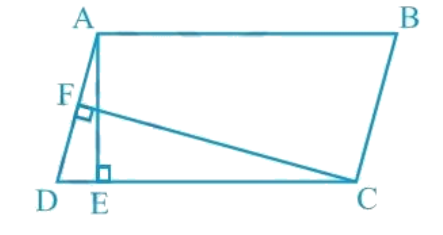In Fig. 10.54, a circle touches all the four sides of a quadrilateral ABCD with AB=6cm , BC=7cm and CD=4cm . Find AD . (FIGURE)
To solve the problem of finding the length of side AD in the quadrilateral ABCD, where a circle touches all four sides, we can follow these steps:
1. Understand the Properties of the Quadrilateral:
Since the circle touches all four sides of the quadrilateral ABCD, it is known as a tangential quadrilateral. A key property of such quadrilaterals is that the sum of the lengths of the opposite sides is equal.
2. Assign Variables:
Let:
- AB = 6 cm
- BC = 7 cm
- CD = 4 cm
- AD = x (the unknown we need to find)
3. Set Up the Equation:
According to the property of tangential quadrilaterals:
AB+CD=AD+BC
Substituting the known values into the equation gives:
6+4=x+7
4. Simplify the Equation:
Combine the left side:
10=x+7
5. Solve for x:
To find x (which represents AD), subtract 7 from both sides:
x=10−7
x=3
6. Conclusion:
Therefore, the length of side AD is 3 cm.
Since the circle touches all four sides of the quadrilateral ABCD, it is known as a tangential quadrilateral. A key property of such quadrilaterals is that the sum of the lengths of the opposite sides is equal.
Let:
- AB = 6 cm
- BC = 7 cm
- CD = 4 cm
- AD = x (the unknown we need to find)
According to the property of tangential quadrilaterals:
AB+CD=AD+BC
Substituting the known values into the equation gives:
6+4=x+7
Combine the left side:
10=x+7
To find x (which represents AD), subtract 7 from both sides:
x=10−7
x=3
Therefore, the length of side AD is 3 cm.
Topper's Solved these Questions
Similar Questions
In Fig. 10.57, a circle is inscribed in a quadrilateral ABCD in which ∠B=90o . If AD=23cm , AB=29cm and DS=5cm , find the radius r of the circle. (FIGURE)
View SolutionCalculate the area of the quadrilateral ABCD as shown in Fig.33, given that BD=42 cm , AC=28 cm , OD=12 cm and AC⊥BD .
View SolutionIn Fig. 4.57, AE is the bisector of the exterior ∠CAD meeting BC produced in E . If AB=10cm , AC=6cm and BC=12cm , find CE . (FIGURE)
View SolutionIn a ABC , D and E are points on the sides AB and AC respectively such that DEBC If AD=6 cm , DB=9 cm and AE=8 cm , find AC . (ii) If ADDB=34 and AC=15 cm , find AE . (iii) If ADDB=23 and AC=18 cm , find AE .
View SolutionIn a ABC , D and E are points on the sides AB and AC respectively such that DEBC If AD=2 cm , AB=6 cm and AC=9 cm , find AE . (ii) If ADBD=45 and EC=2.5 cm , find AE . (iii) If AD=x , DB=x−2 , AE=x+2 and EC=x−1 , find the value of x .
View SolutionIn Figure, ABCD is a parallelogram, AE ⊥DC and CF⊥AD . If AB=16CM, AE=8cm and CF=10cm, find AD

View SolutionWhich of the following pairs of triangles are congruent? If they are congruent, write out the pairs of equal angles. ABC:AB=3cm, BC=4cm, CA=2 cm DEF:DE=2 cm, EF=3 cm and FD=4 cm PQR:PQ=17 cm, QR=15 cm, PR=18 cm DEF:DE=18 cm, EF=17 cm, DF=15 cm .
View SolutionIn Figure, a circle with centre O is inscribed in a quadrilatal ABCDsuchthat,iouchessides BC, AB, AD na CD AT POINTS P, Q, R and S respectively. If AB=29cm,AD=23cm,∠B=900 and DS=5cm, then the radius of the circle (in cm) is 11 (b) 18 (c) 6 (d) 15
View SolutionIn Fig. 10.103, a quadrilateral ABCD is drawn to circumscribe a circle such that its sides AB, BC, CD and AD touch the circle at P, Q, R and S respectively. If AB=x cm , BC=7cm , CR=3cm and AS=5cm , then x= (FIGURE) (a) 10 (b) 9 (c) 8 (d) 7
View SolutionIn Fig. 4.60, check whether AD is the bisector of ∠A of ABC in each of the following: (FIGURE) AB=5cm, AC=10cm, BD=1.5cm and CD=3.5cm (ii) AB=4cm, AC=6cm, BD=1.6cm and CD=2.4cm (iii) AB=8cm, AC=24cm, BD=6cm and BC=24cm
View Solution
